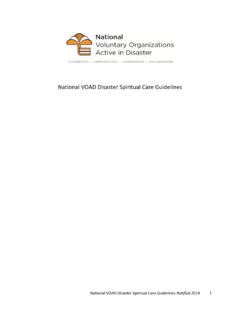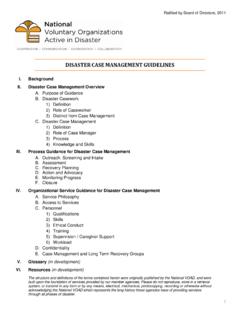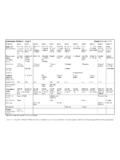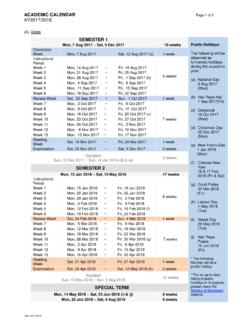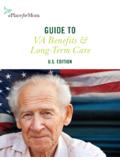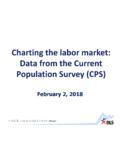Transcription of LONG TERM RECOVERY GUIDE - National VOAD
1 Ratified by Board of Directors, 2012 long TERM RECOVERY GUIDE Ratified by Board of Directors, 2012 TABLE OF CONTENTS Acknowledgements & Introduction Chapter 1. DISASTERS AND long TERM RECOVERY Chapter 2. ORGANIZING A long TERM RECOVERY GROUP Chapter 3. long TERM RECOVERY ADMINISTRATION Chapter 4. DISASTER CASE MANAGEMENT IN long TERM RECOVERY Chapter 5. CONSTRUCTION MANAGEMENT IN long TERM RECOVERY Chapter 6. VOLUNTEER MANAGEMENT IN long TERM RECOVERY Chapter 7. COMMUNICATIONS IN long TERM RECOVERY Chapter 8. DONATIONS MANAGEMENT IN long TERM RECOVERY Chapter 9.
2 SPIRITUAL CARE IN long TERM RECOVERY Chapter 10. FINANCIAL CONTROLS AND REPORTING Chapter 11. WHEN THE WORK IS FINISHED APPENDIX INDEX Appendix 1. COMMONLY USED ACRONYMS IN DISASTER WORK Appendix 2. COMMON terms AND DEFINITIONS Appendix 3. FEDERAL DISASTER PROGRAMS Appendix 4. FEMA VOLUNTARY AGENCY LIAISONS AND DONATIONS SPECIALISTS Appendix 5. SAMPLE JOB DESCRIPTIONS Appendix 6. SAMPLE FORMS Appendix 7. SAMPLE DOCUMENTS Appendix 8. WEB RESOURCES Ratified by Board of Directors, 2012 1 ACKNOWLEDGEMENTS & INTRODUCTION ACKNOWLEDGEMENTS Revision of the National Voluntary Organizations Active in Disaster ( National VOAD) long Term RECOVERY GUIDE has been a lengthy project, accomplished through the cooperation, communication, coordination, and collaboration of numerous National VOAD members, partners and committees.
3 Were we to try to name everyone who had a hand in this project, we would surely leave someone out. So, to the many individuals and organizations who made a contribution we simply want to say, thank you! Thank you to all of the volunteers who put their time and effort into making this project a success. INTRODUCTION National Voluntary Organizations Active in Disaster ( National VOAD) is a coalition of organizations that prepare for and respond to the RECOVERY needs of America s communities in times of disasters. Members of the National VOAD collaborative include dozens of the most reputable National non-governmental organizations in the country and 55 State and Territory VOADs, representing local VOADs and hundreds of additional organizations.
4 With over 40 years of respected service collaboration, the National VOAD member agencies provide skilled direct services along the continuum from disaster prevention and preparedness to response, RECOVERY and mitigation. The National VOAD member agencies provide their services through comprehensive, coordinated volunteer resources in partnership with emergency managers. This cooperative effort has proven to be the most effective way for a wide variety of volunteers and organizations to work together in a crisis. For more information about National VOAD and its member agencies please go to Throughout this RECOVERY GUIDE you will find references and links to other National VOAD resources.
5 Of particular interest are the National VOAD Points of Consensus documents which outline minimal standards, ethical principles or operational principles related to various functions of voluntary organizations in RECOVERY . National VOAD Points of Consensus are developed and approved through careful, collaborative and respectful conversation. Organizations choosing membership in National VOAD agree to abide by approved Points of Consensus. National VOAD members and partners have learned a lot over decades of experience in disaster response and RECOVERY . Those hard-earned lessons are captured in this long Term RECOVERY GUIDE with our fervent hope that your RECOVERY group will add your own experience to ours as you learn and share the best ways to build a better community for everyone.
6 We do believe that we are all in this together, that together we can accomplish what none of us can achieve alone. National VOAD members are available to you as resources and partners as you take the difficult steps of forming your local long -term RECOVERY effort. Please take the best of what we have to offer in experience and join us in the commitment to helping communities recover who have suffered disaster. Those who have participated in the creation of this GUIDE hope that it will be useful as you embark on your own community RECOVERY . What follows is guidance; what you do with it is yours.
7 Ratified by Board of Directors, 2012 2 CHAPTER 1: DISASTERS AND long TERM RECOVERY When organizations and/or individuals work together in disaster response and RECOVERY , it s always helpful if we re speaking the same language. The next few pages will introduce basic terms and understandings about disasters, along with the processes and the agencies / organizations that build a community s capacity for long term RECOVERY . Disaster is a natural or human-caused incident that disrupts normal life, causing physical and/or emotional trauma and/or damage to property and/or community infrastructure.
8 Disasters may include hurricane, tornado, wind storm, flood, tidal wave, tsunami, earthquake, volcanic eruption, landslide, mudslide, snow or ice storm, wild fire, explosion, acts of public violence or terrorism, or other human caused or technological events involving toxic and / or radiological materials, etc. RECOVERY is the period following a disaster and the community s early response to that disaster, whereby things return to a new normal. After neighbors move from shock to action, communities organize by implementing plans and structures aimed at bringing help to affected individuals and families in a holistic, integrated process that brings needed resources to the most vulnerable.
9 RECOVERY following each disaster is unique and may last weeks or years. Disasters are never welcome, but they give communities an opportunity to build back stronger. Often, damages sustained in disaster can be prevented from recurring by implementing a long -term RECOVERY strategy grounded in risk reduction analysis and mitigation. PHASES OF DISASTER Communities are always in one of the phases of disaster, which often overlap or intertwine preparedness, response, RECOVERY and mitigation. Mitigation Incident Preparedness Emergency/Relief RECOVERY Short/ long Response Emergency/Relief Ratified by Board of Directors, 2012 3 RECOVERY is not only about the restoration of structures, systems and services although they are critical.
10 A successful RECOVERY is also about individuals and families being able to rebound from their losses, and sustain their physical, social, economic and spiritual well-being. 1 Preparedness Preparedness includes activities that seek to prevent casualties, expedite response activities and minimize property damage in the event of a disaster. It is a continuous process for communities as they constantly strive to improve their readiness. Some examples of preparedness activities are: Community education and awareness. Assessment of community hazards and risks.
